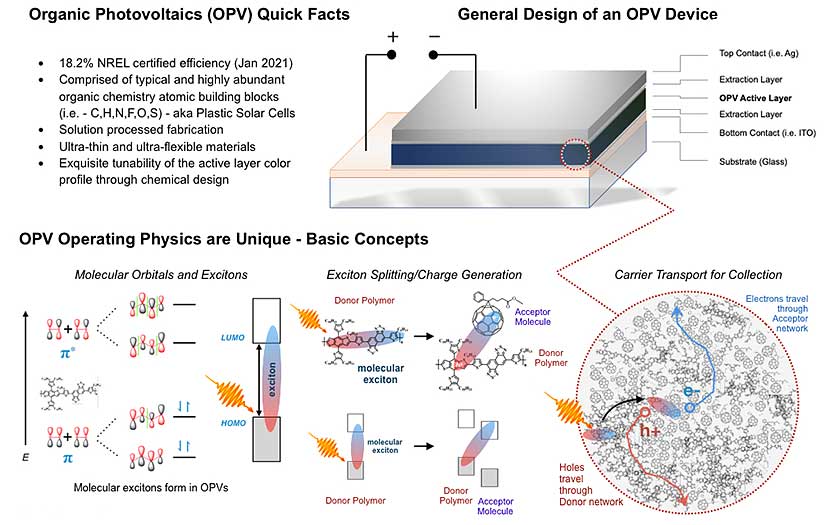New Design Strategy Pushes Organic Photovoltaics Past 18% Efficiency
Holistic Strategy Optimizes Electronic Structure and Morphology, Opening a New Route to Higher-Efficiency Organic Photovoltaic Devices
National Renewable Energy Laboratory (NREL) Research Scientist Bryon Larson, as part of an international research team, has achieved a record-breaking 18.07% power conversion efficiency from an organic photovoltaic (OPV) solar cell—or as such materials are better known: plastic. Historically, OPV cells have mostly improved through an iterative process. However, Larson and his collaborators have hit upon an “aha!” moment with a new design strategy that simultaneously improves the cell’s open-circuit voltage, short-circuit voltage, and fill factor.
Concurrently improving all three of these primary metrics—which represent how efficiently a solar cell converts sunlight into electricity—is difficult due to the traditional constraints of only using two components to create the binary donor-acceptor blend in an OPV cell’s light absorbing layer. Changing a single component to improve one metric can negatively affect another, leading to performance trade-offs.
“The name of the game for advancing OPV is new materials,” Larson said. “But because of the way that OPVs work, every time you introduce a new material into the absorber blend, you have to reoptimize everything about the cell design. It’s a time-consuming, haphazard process, like trying to find a needle in a haystack. Our strategy demonstrates a quaternary, four-component, approach where each component works in synergy to avoid performance trade-offs and to produce a high power conversion efficiency.”
The absorber layer in an OPV cell is responsible for light absorption, exciton splitting to generate positive and negative charges, and effective transport of charges to the contacts to produce photocurrent (see image below). The design of a traditional OPV cell struggles to balance the electronic and morphological characteristics of just two sets of molecules or polymers for all these functions.
Larson, working with researchers from Shanghai Jiao Tong University and the University of Massachusetts Amherst, showed that using four components in an OPV device’s active layer could better balance the microstructure and electronic function of the cell’s absorber layer. This holistic strategy is described in the Nature Communications article “Single-layered organic photovoltaics with double cascading charge transport pathways: 18% efficiencies.”

Quaternary Blends Improve Power Conversion Efficiency
The research article describes numerous strategies to optimize light absorption, carrier transport, and charge-transfer-state energy levels when the chemical structures and excited-state properties of the additional donor and acceptor components are considered. On a molecular level, each of the four components has unique absorption, transport, and electrical properties that can contribute to realizing the optimal OPV configuration.
The quaternary donor-acceptor mixture makes double cascading energy level alignment possible in the active layer, enabling efficient exciton splitting and long carrier lifetimes. The second donor component generates cascading charge-hopping channels that allow manipulation of multiple charge-transfer pathways to maximize the carrier transport and reduce recombination. The second acceptor component improves electron transport and promotes extraction efficiency. The electronic structure and morphology of each of the four components of the quaternary blend mixture are fine-tuned through molecular design to maximize light absorption, exciton splitting, and carrier extraction, ultimately improving power conversion efficiency in OPV devices.
The Potential of Organic Photovoltaics
OPV materials are semiconductors made up of common organic elements like carbon, hydrogen, nitrogen, fluorine, oxygen, and sulfur. They are man-made molecules and polymers that can be synthesized in a chemistry lab. These non-toxic ‘plastics’ can even be easily recycled back into their constituent building blocks. Their raw materials are cheap, infinitely abundant, and the manufacturing processes for creating them have been used for decades in industries that fabricate household items like plastic wrap and Tupperware.
OPV blends are handled in liquid form and sprayed or coated onto rigid or flexible surfaces, meaning OPV modules could be printed in the same way as newspapers. The number of potential applications is broad, yet OPV’s have only been intensively researched since the early 2000s, after a relatively new molecule called a fullerene (its discovery led to a Nobel Prize in Chemistry in 1996) was incorporated as the acceptor component in OPV cells. A second Nobel Prize in 2000 recognized the discovery and development of conductive polymers.
And that sparked the attention of Bryon Larson. “Both of those Nobel Prizes were a really big deal in the history of OPV,” Larson said. “Everyone thinks of plastics as insulators, but to have a polymer-based electronic device that acts as a semiconductor—that opened up a world of new options.”
Learn more about NREL’s OPV research.
Last Updated May 28, 2025
